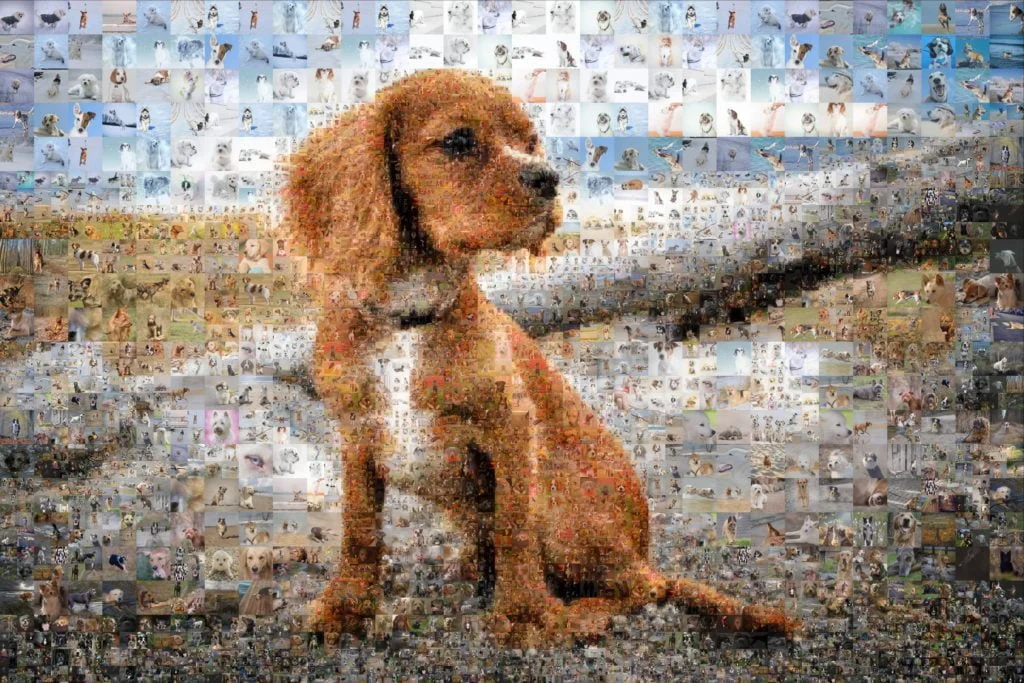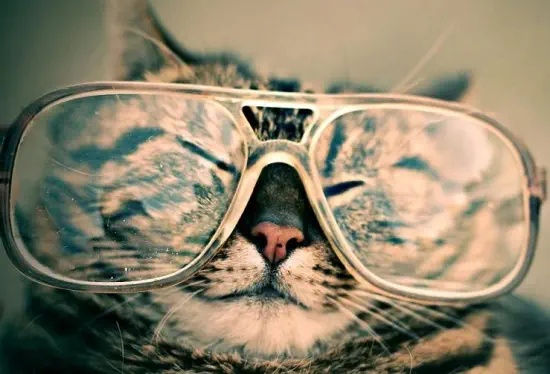Stereogram pictures
Exploring Stereogram images - 3D illusion
Exploring Stereogram pictures: A Dive into Hidden Dimensions
Stereogram images are a captivating art form that combines visual perception with creative design. These images trick the brain into revealing hidden 3D shapes within a flat 2D picture. This optical illusion has fascinated artists, photographers, and audiences for many years. In this article, we will uncover the secrets of stereogram images, how they function, their benefits, and tips for creating your own.
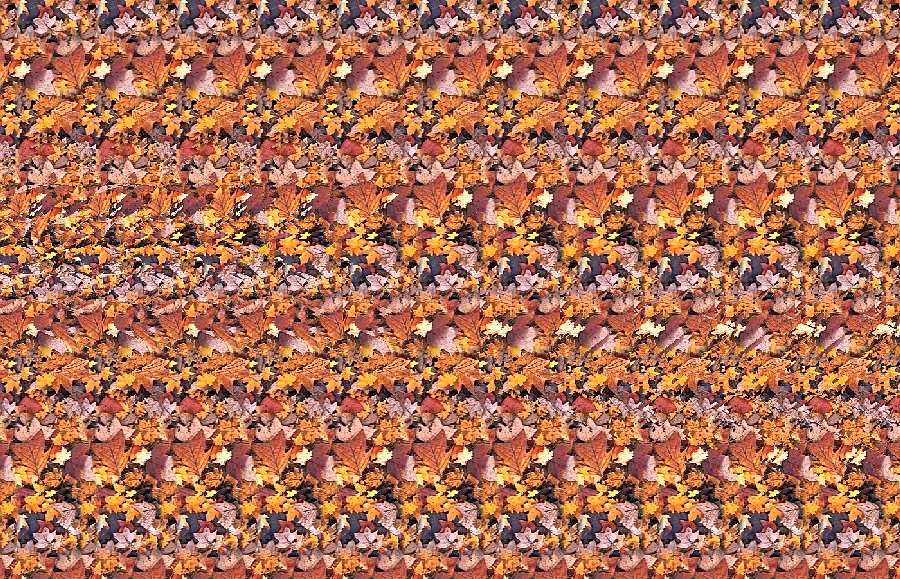
What Are Stereogram Images?
Stereogram pictures are uniquely designed visuals that hide three-dimensional shapes or patterns. At first, they may look like simple 2D pictures, but with the right technique, your brain can uncover hidden layers, creating a sense of depth. This effect is achieved by adjusting colors, textures, and patterns to stimulate the brain’s depth perception.

How Do Stereogram pictures works?
The magic of stereogram pictures is rooted in visual perception. They typically operate through a method called “autostereogram,” which shows a single image with repeating patterns. When you focus on the image correctly, your eyes diverge, allowing you to interpret the repeated patterns as depth and see the concealed 3D object or shape. There are two primary types of stereograms: single-image and multi-image stereograms. Single-image stereograms use depth cues hidden in one picture, while multi-image stereograms layer multiple elements to create a three-dimensional effect.

Convergent and Divergent Stereograms
Parallel view vs Crosseyed view
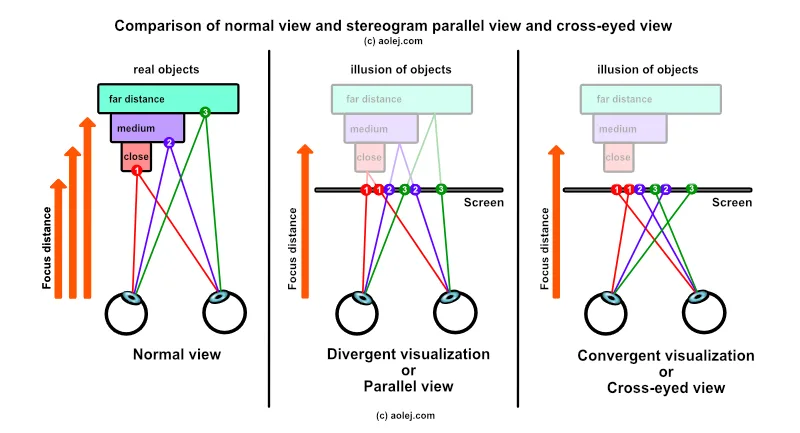
Stereograms are optical illusions that allow us to see hidden 3D images within a 2D picture. There are two main types of stereograms: convergent and divergent. Both require different viewing techniques, but both offer a fascinating experience for the viewer.
Convergent stereograms or cross-eyed: These require the viewer to focus their eyes inward, towards each other, to create a 3D image. When done correctly, the image pops out in a seemingly magical way.
Divergent stereograms or parallel view: These require the viewer to look “through” the image, focusing their eyes outward. This allows the hidden 3D object to emerge as your eyes diverge.
Both types rely on the brain’s ability to perceive depth from slightly offset images. Learning to view these stereograms can be challenging but is a rewarding exercise for the eyes and brain.
What stereogram can you see? Parallel or Crosseyed?
Do simple test what type of stereograms you can see. Focus on eyes on the top. When you seen 3 eyes, check what is in the front letter P or C.
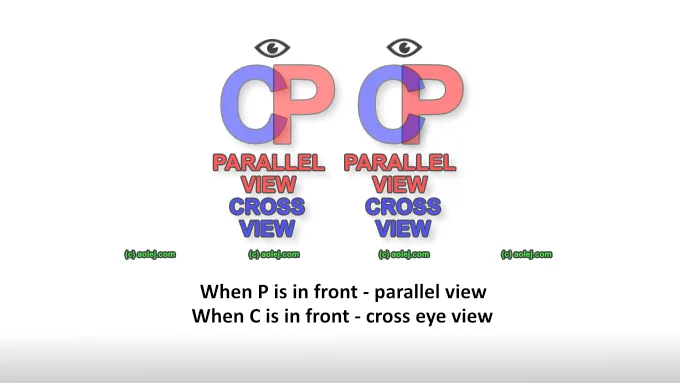
Why Are Stereogram pictures So Popular?
Stereogram pictures have become popular for various reasons. They offer an engaging and interactive experience for viewers. As people try to uncover the hidden 3D features, they become immersed in the process, igniting curiosity and amazement. Additionally, these images provide a fun way to challenge the mind and enhance visual skills, particularly depth perception.
Want to create your own stereograms with Stereogram Explorer?
40 amazing 3D Stereograms video
created with Stereogram Explorer
Stereogram Explorer
Stereogram Explorer is a software program that helps users make and view various stereograms, also called autostereograms or “magic eye” images. These images are optical illusions that trick the eyes into seeing a 3D picture by using the different perspectives of each eye.
With Stereogram Explorer, users can create their own stereograms easily by using different textures or by making random dot stereograms and drawn illusions. The software comes with a collection of free textures designed for stereograms and sample 3D models for those who want a bigger challenge.
Users can view the created stereograms in full-screen mode, which enhances the resolution and detail. This feature is especially helpful for examining more complex stereograms that need careful focus to reveal the 3D effect.
Whether you are a seasoned stereogram artist or a newcomer eager to explore this intriguing optical art, Stereogram Explorer is a fantastic tool. Its easy-to-use interface, diverse features, and included textures and 3D models make it perfect for creating and discovering both simple and complex stereograms, cross-eye 3D images, and other optical illusions.
How to use Stereogram images in business?
Stereogram images, often called “3D images,” can be an effective way for businesses to attract attention and differentiate themselves in a busy market.
Here are some suggestions for incorporating stereogram images into your business:
- Include stereogram images in your marketing materials: These images can add a unique and striking element to your brochures, flyers, and social media posts. They can help present your products or services in a way that feels more engaging and memorable to potential customers.
- Design custom stereogram images: You can create personalized stereogram images, like using your company logo. This approach allows you to display your offerings in a visually appealing and distinctive manner.
- Integrate stereogram images into your website design: Using stereogram images on your website can enhance its visual appeal and make it more memorable for visitors. They can serve as background images, header images, or part of your overall design. Just be sure to use them thoughtfully to improve the user experience.
- Provide stereogram images as a service: If you have skills in creating and viewing stereogram images, consider offering this as a service to your clients. This could be a unique offering that helps you stand out from the competition.
By utilizing stereogram images in your business, you can capture the interest of potential customers and make a mark in a competitive market. Try them out and discover how they can enhance your business.
How to view Stereograms?
Most of Stereograms are diverging or parallel. It means that focus point is behind the monitor or printed stereogram. There are many ways how to train:
- Method 1 focus behind target – place something behind monitor 30cm/feet and you can see it. Focus your eyes on it for few seconds and swing your eye focus to stereogram. If you don’t see depth in stereogram swing your eyes and focus behind monitor. Repeat it again and try stay focused behind monitor – 2 second behind monitor, 1 second on stereogram.
- Method 2 de-focus your eyes – Move your head very near to stereogram image, just few centimeters/inches. Your eyes can’t focus for this distance. Try stay focused to distance and slowly move your head back. In distance about 30 cm/11 inches you can start to see depth of stereogram.
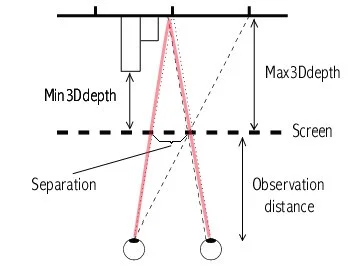
What is stereogram or autostereogram?
Stereograms are standard images that use the difference in perspective between the left and right eye views to create the illusion of depth and three-dimensionality. There are several types of stereograms – autostereograms, SIRDS (Single Image Random Dot Stereograms), and SIS (Single Image Stereograms). Here’s a closer look at each type:
Autostereograms: Autostereograms are stereograms that can be viewed without the need for special glasses or other viewing aids. They typically use repeating patterns or hidden images to create the 3D effect. One popular example of an autostereogram is the “Magic Eye” series of books, which use repeating patterns of dots to create 3D images.
SIRDS (Single Image Random Dot Stereograms): SIRDS are stereograms that use a single image made up of randomly placed dots to create the 3D effect. The dots are arranged in such a way that each eye sees a slightly different pattern, which creates the illusion of depth.
SIS (Single Image Stereograms): SIS are stereograms that use a single image to create the 3D effect. Unlike SIRDS, SIS do not use randomly placed dots to create the 3D effect. Instead, they use the difference in perspective between the left and right eye views to create the illusion of depth.
While all three types of stereograms use the difference in perspective between the left and right eye views to create the illusion of depth, they each have their own unique characteristics and uses.
Autostereograms are great for creating 3D images that can be viewed without special glasses or viewing aids, while SIRDS and SIS are useful for creating more complex 3D images with greater detail. No matter which type of stereogram you choose, they can all be a fun and interesting way to add depth and dimension to your images.

